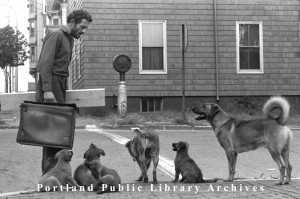July/August 2015
By Helen Coxe
 He was a wraith, he was real, and out there is a cluster of people who can recall him. He would materialize unexpectedly out of nothing, a loping Civil War refugee with his bedraggled troops strung in a line behind him. Circumstances kept them always on the move. The Dog Man would never show if you went looking for him; he was capricious that way and kept his schedule to himself. Such an ugly, motley bunch they were, man and dogs: One large gold dog near the end of the string had a frozen hind leg held always at half-mast while soldiering on, three legs doing extra duty. The Dog Man did the baying when necessary, and the dogs followed in silence ,dematerializing as they went, absorbed by the shadows.
He was a wraith, he was real, and out there is a cluster of people who can recall him. He would materialize unexpectedly out of nothing, a loping Civil War refugee with his bedraggled troops strung in a line behind him. Circumstances kept them always on the move. The Dog Man would never show if you went looking for him; he was capricious that way and kept his schedule to himself. Such an ugly, motley bunch they were, man and dogs: One large gold dog near the end of the string had a frozen hind leg held always at half-mast while soldiering on, three legs doing extra duty. The Dog Man did the baying when necessary, and the dogs followed in silence ,dematerializing as they went, absorbed by the shadows.
Those days, there wasn’t much to the waterfront except decay, but the decay was generous. There were no sharp edges of prosperity hard between land and water. Splintered wood merged with the tides and mud, or blended with crumbling asphalt and chunks of waste granite, lavish spreads of broken bricks, glass. Sometimes the sunlight would hit just right and the ground at your feet would sparkle, flashing silver. Such beauty was a rare thing. The decay had a rich variety to it: a texture of homemade bread that was a feast for the eye. All the many stinks of the town and waterfront were there for the cataloguing and analyzing.
The unattended waterfront enabled The Dog Man to live in lonely splendor in a reclaimed metal shack, right at the water’s edge with rotting pilings as his view. The Dog Man shifted, moved on a whim to different quarters, but he always seemed to keep a roof over their heads. How did they manage the winters? There must have been magic, or perhaps there was compassion. Strange kind of benevolence, a blind eye.
The Dog Man had his rounds–ellipses, really, is what they were. His unrecorded journeys rivaled those of Odysseus. He would cross streets with that undulating, attenuating string of woeful canines fanning out behind like geese in flight, the last animal just making it to the curb in time as the oncoming car, with driver’s patience stretched to the limit, accelerated away. Legends can begin this way.
His persona was a fierce one. He was as grubby as his charges. Intimidating, he loomed as alpha to the pack of followers that had been homeless before he gathered all of them to him. Down the Bob Solotaire streets lined with squat, mean buildings that gave no hint of what they would become, The Dog Man and his pack would walk, and walk with purpose, and his sharp commands echoed off the bricks. Man and dogs compelled the eye to look, to see and to be repelled, forcing most to scurry to a safer route or watch the wall while the Gentleman went by. On they would go by the Hollow Reed where they never stopped and then back toward the Hill past the dark lair of Amato’s with its shadows, back toward the wharves and the water. Something like home must have waited there.
The wanderings ceased. A stillness hovered over the waterfront like sea smoke. One day, dogs and man were no longer there and their leaving had taken some of the city’s breath. Perhaps the dogs had caught an exotic scent coming on the breeze and asked to go. The Dog Man went on sabbatical once before, melting south to Biddeford, another brick-made town that seemed to promise shelter for roughened street refugees. But there were no warrens of safety found, and The Dog Man brought his troops back north.
It was when all his dogs were taken and an itinerant sign painter was all that remained, that The Dog Man turned his back and walked into the silence. n
Helen Coxe won the Mary B. Sinkinson short story prize while at Bowdoin College. She lives in Cumberland Center.





0 Comments